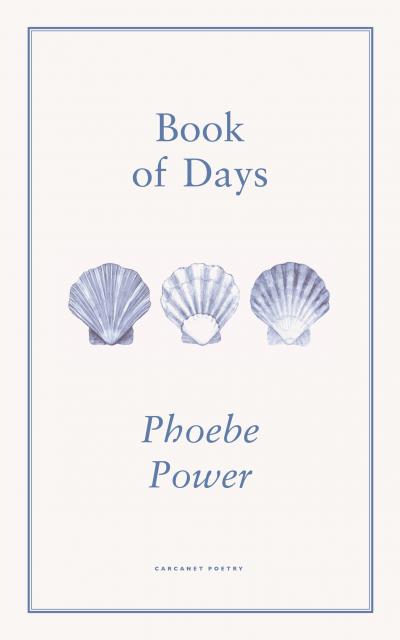The word “shrine” somersaults me back to the path of the Camino de Santiago. I have lost count of the faces that smiled up from photos positioned in the hollow of trees, some with little plastic figurines for company, others set in stone next to a sculptural pile of pebbles. Some of the shrines also sheltered a handwritten prayer or a crucifix; most had burnt-out tea-candles.
Phoebe Powers imagined her debut poetry collection, Shrines of Upper Austria, “as a shrine: a gathering of objects, words and images important to someone, both as discrete objects and as a composition”. Her second poetry collection, Book of Days, is again set amongst the shrines, this time of the Camino. The collection is a tessellation of poems recounting her 790 km pilgrimage from St Jean Pied de Port in the Pyrenees to the cathedral in Santiago de Compostela in Galicia. Christians have walked this route since the ninth century. Even fictional ones: Chaucer’s Wife of Bath from The Canterbury Tales completed the Camino: “she hadde been/In Galicia at Saint James”. Nowadays the route is trekked by pilgrims of all faiths, agnostics and atheists alike. Most are compelled to walk the route for a reason: “Why are you walking the Camino?” is the question you’re as likely to hear as the parting phrase “Buen Camino!” The number of shrines and memorials dotting the path are a reminder that many walk the path to assuage grief.
 Pilgrimage has always lent itself to metaphor. While Chaucer used it to create a jewel of social realism and irony, Power’s collection delves deep into questions of loss and belonging, focusing on the stories that weigh down the backpacks, however light their owners may be travelling. She refers to herself and her fellow pilgrims as “beads on a string” and threads their various stories through the narrative as if they are indeed precious beads. Pia tells Powers about how hard it is to leave her “bad marriage” after 37 years:
Pilgrimage has always lent itself to metaphor. While Chaucer used it to create a jewel of social realism and irony, Power’s collection delves deep into questions of loss and belonging, focusing on the stories that weigh down the backpacks, however light their owners may be travelling. She refers to herself and her fellow pilgrims as “beads on a string” and threads their various stories through the narrative as if they are indeed precious beads. Pia tells Powers about how hard it is to leave her “bad marriage” after 37 years:
But the Camino gives me
courage I didn’t have before. When I sit on the side of the
mountain and look out I feel stronger, and glad again to be
alive.
Mélany “lost the new child that had been in her womb,/her abdomen a web of pain”, the sticky consonance across womb, abdomen and web emphasising the physical discomfort networking with grief. Rachel survived a “freefalling plane”. It seems that many on the Camino have survived their own metaphorical freefall. Ciara’s solution to this is to set up a “Currency of Kindness, to motivate people/to be kind. I suppose it will be/a kind of an app.”
There are those Power meets that she doesn’t see again. Other names reappear in the text with the regularity of a chorus. She encounters Sven, a priest, and his wife Cecilia, a nurse, on day two and comes across them again on day eight:
The path gets high and sandier;
finally we talk. There was one of their children who died
very young.
Patrick, “a skinny streak of brown-black paint, yellow teeth”, has walked from Helsinki carrying the ashes of his friend, Martin. He’s overcome hard winter conditions, border control issues, and was robbed in France of his rucksack, tent, passport and money. She later stumbles upon a message from him “in red marker-pen” amongst the shrines:
On a large stone under a cross
Among photos and pebbles:
MARTIN
10-9-84
17-1-2018
What of Power’s own reason for walking the Camino? The reveals are scattered and raw, yet intrinsic to the collection’s structure. She feels lost. In the intimacy of the exchange with Sven and Cecilia, she confides that she’s searching for “a community/I can be myself in”. Five days later she says “I am like a loose pin/in the map of pathways/shaken end to end or side to side”. There are references to complicated relationships with her sister, and with perhaps an ex, N. While watching the swing of the botafumeiro in Navarette, she confides:
[…] I am still and think of N.; a
person who hates me.
I press him in a hug with all the love I can to expel the
pieces of cut up anger in him […]
The peak of the collection’s narrative arc falls during “MESETA”, the 34-page section devoted to the so-named plateau that covers 40% of Spain and 240 arduous kilometres of the Camino. It’s treeless, exposed to extremes of heat and cold, and offers little shade or respite; Powers notes its “Emptiness./The shoulders of the other hillsides sit back round us: rigid/ bone structures, houseless”. During this traverse, Power loses sight of the yellow arrows that regularly appear on trees, stones and asphalt that “send us on like an addiction”.
The collection is divided by walking days – as the title intimates – and some poems are separated by numbers or asterisks. Place names appear in small print in the margin and can be referenced against the sketched map that opens the book. The poems meander in and out of free verse, prose, and calligrams (a “shrine symbol” of crosses spreads over pages 48-49). White space is used to convey changes in landscape, the distance and stark barrenness of the Meseta plateau for example, or new walking companions. It emphasises the “still space” of the swinging botafumeiro and the togetherness of a pair of “married” oak trees one “pink dawn”. This fragmentary form lends itself to memoir as well as to the authentic representation of the interactions experienced walking the Camino.  Only two poems in the collection are titled, and one of these, a prose poem “The Ocean”, is devoted to her sister’s unsuccessful visit or “quick dip” into the Camino at Léon. Power writes here that the Camino is part of a “process”, “altering my composition in fundamental ways”, the pun in “composition” mirroring the change in poetic form while accentuating the extent to which their relationship agitates her very being. The “process” is something for which she has “paid dearly, snipping ties”. The visit is meant to be a bonding experience, yet instead it exposes the fathoms separating the siblings: her sister remains at the “surface” while Powers continues “sticking down deep, on the sea-bed”.
Only two poems in the collection are titled, and one of these, a prose poem “The Ocean”, is devoted to her sister’s unsuccessful visit or “quick dip” into the Camino at Léon. Power writes here that the Camino is part of a “process”, “altering my composition in fundamental ways”, the pun in “composition” mirroring the change in poetic form while accentuating the extent to which their relationship agitates her very being. The “process” is something for which she has “paid dearly, snipping ties”. The visit is meant to be a bonding experience, yet instead it exposes the fathoms separating the siblings: her sister remains at the “surface” while Powers continues “sticking down deep, on the sea-bed”.
The verb “fold” is conspicuous in its repetition throughout the text: mountains and mists “fold”; buildings “fold” their shadows; emotions “unfold” at Carrión de los Condes in the Church of Santa Maria; a tree “turned white/covered in paper/dreams folded/up or made into scrolls”; on the way out of Burgos “trees and birds have long been/up, folding and unfolding wild, while the people are still/inside”; a mediaeval church is “folded in its triangle of green”. A “fold” is a congregation and it’s hard to disassociate the use of thee word from Power’s desire to belong. Her use of “fold” may also be suggestive of a quest for regaining control over her relationships and emotions. In the Church of Santa Maria, when nuns ask Power and her companions about their reasons for walking the Camino, there is weeping, “all of us find we’re unfolding/the inexplicable… the room disintegrates in shapes of tears and/broken sentences, the things we want to say”. Their tears and “broken sentences” reveal more of a spontaneous unravelling of emotion rather than a considered response to the nuns’ question, as “unfold” might imply. This semantic origami may also refer to form, where the collection itself provides an enclosure: a fold of sorts. Power’s eye for detail is exquisite whether in macro – “At my ear/a beautiful web,/dew-filled silk beads” – or in panoramic – “And all the way to the crest, where silhouettes of cattle/and pilgrims prance in wind-clattering iron and through long/grass, ankle-deep”. She details her companions with witty, sometimes soul-piercing observations: Matt, “A young American with neat edges, like a new/toothbrush”; Shep, a guitarist who plays as if he’s “brushing the tops of/individual blades of grass”. Powers imagines “the bees/zooming to Sam’s/warm eyes, his smile”; the voice of a girl she meets in a hostel “is wondering and generous/like the edge of a wave over sand”.
Power’s eye for detail is exquisite whether in macro – “At my ear/a beautiful web,/dew-filled silk beads” – or in panoramic – “And all the way to the crest, where silhouettes of cattle/and pilgrims prance in wind-clattering iron and through long/grass, ankle-deep”. She details her companions with witty, sometimes soul-piercing observations: Matt, “A young American with neat edges, like a new/toothbrush”; Shep, a guitarist who plays as if he’s “brushing the tops of/individual blades of grass”. Powers imagines “the bees/zooming to Sam’s/warm eyes, his smile”; the voice of a girl she meets in a hostel “is wondering and generous/like the edge of a wave over sand”.
I walked just a third of the distance that Power walked, also alone, and it remains one of the most treasured experiences of my life. Book of Days evokes everything I loved about the Camino de Santiago: it is a celebration of being alive, of lives lived, of the world around us; it’s soothing in its meditative comfort. It captures the beauty and difficulty of being. The people she meets, and their stories will be remembered long after the book is put down. It's a narrative for the senses: I can hear the clack of walking poles, the clink of scallop shell, the quena flute and bagpipes; I can feel feel the rhythm of the salsa and jive and am refreshed by sweet peach juice. “Only this way can you reach the deep places,” Power writes, “where the root stems are pale and fleshy; only here are the most tensile patterns visible.” Buen Camino.
- Book of Days by Phoebe Power (Carcanet Press, £11.99)
- Read more book reviews on theartsdesk















Add comment